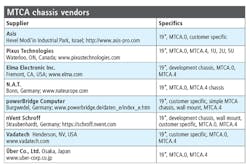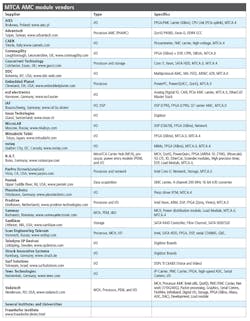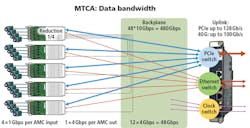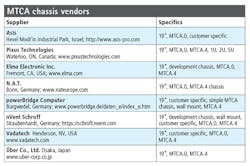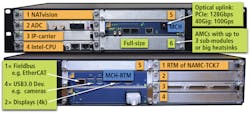Open embedded architecture enables machine vision camera synchronization
Open-standard embedded computing architectures such as MicroTCA, cPCI Serial, and COM Express provide long-term scalability, reduced risk and time-to-market in multi-camera machine vision applications.
Justin Moll
Inmachine vision applications a significant amount of moving parts require control and synchronization. One such example is in a blow-fill-seal process, in which plastic is formed, filled with a liquid parenteral drug, and sealed, in a continuous automated process. Though blow-fill-seal packaging tends to result in fewer particles in the liquid, inspecting the packages for particulates is still necessary.
Embedded computing systems—and open-standard architectures specifically—offer advantages for long-term success, as there are many vendors designing various types of products with open specifications that are backwards compatible and scalable, and thus easily replaced or upgraded.
In one suchpharmaceutical inspectionsystem for a blow-fill-seal process, open-standard embedded computing architecture plays a rather signficant role in achievingsuccess.
In this system—involvinghigh-speed imagingfor error identification—all products are inspected and documented. More than 20 machine visioncamerasmonitor the process, requiring asynchronized image acquisition system with precision timing, as well as complex control of the frame grabber and its peripherals over the I/O’s.
One of the control processes in the system has eight 5 MPixel industrial cameras taking 20 images of a given product each, with two of the cameras being triggered together simultaneously. Every three images captured by the eight cameras are superimposed, sharpened, and reduced, resulting in a true representation of the object, enabling the inspection process to detect foreign substances, inclusions in the material, or hole formation.
As a result, particles that are not allowed in pharmaceutical liquids can be detected. This method has far better results in quality inspection than traditional false-fault identification. This includes:
- Instead of daisy-chaining multiple frame grabbers, simultaneous and synchronized access to more than 20cameras
- Light control
- Drives control
- Shaft encodercontrol
In this machine vision application, the designer utilized a 40 Gigabit Ethernet speed. With the high-speed signaling and multiple port options a 100 G fiber optic uplink was achieved. The MicroTCA architecture used in the pharmaceutical inspection system offers multiple clock/timing signal options for precision timing, which was also critical in this application.
As shown in Figure 1, multiple field-programmable gate arrays (FPGA) can control and interface with up to 48 machine vision cameras. In a 2U 19” rackmount chassis holding 12 advanced mezzanine cards (AMC)—a board architecture that plugs into MicroTCA chassis enclosures—each AMC can connect to 4 cameras.
Figure 1: With 4 ports per AMC, a 2U MicroTCA chassis can have a high-speed, low-latency interface with up to 48 cameras for an inspection system. (Image courtesy of N.A.T.)
MicroTCA.4
Developed by the PCI Industrial Computer Manufacturers Group (PICMG; Wakefield, MA, USA;www.picmg.com), a consortium developing open specifications for the embedded computing community, MicroTCA provides a good example of the capability of these types of open standards. The MicroTCA architecture is a modular backplane-based specification with PCIe, RapidIO, and Gigabit Ethernet connectivity options. Currently, the specification suits 10 GbE speeds across the backplane, but 40 GbE implementations are commonly utilized and the specification is currently in draft for updating this year.
MicroTCA.4—an extension of the MicroTCA architecture—creates a few more possibilities in machine vision applications. In a 2U MicroTCA.4 chassis, for example, developers or systems integrators can utilize up to 6 FPGAs for interfacing with 48 machine vision cameras, synchronizing data via the timing and trigger bus, and pre-processing and aggregation of the massive amount of data via low-latency, point-to-point, board-to-board communication. The quad-core CPU runs the higher level post-processing vision software and controls via real-time field busses e.g. the EtherCAT control I/O.
An example MTCA.4 AMC module for the application is the Xilinx (San Jose, CA, USA;www.xilinx.com) Kintex-7 FPGA-based NAT-AMC-TCK7 from N.A.T. (Bonn Germany; www.nateurope.com). The module is integrated with additional peripherals in a 2U MTCA.4 chassis RackPak/M5-1 by powerBridge Computer (Burgwedel, Germany; http://bit.ly/VSD-PWB), and with eight SFP/SFP+ ports the NAT-AMC-TCK7 connects to eight GigE Vision cameras, and the FPGA performs the preprocessing for the data collection with direct memory access to the internal CPU or via optical PCI Express uplinks to an external CPU. powerBridge Computer integrates the AMC and MicroTCA hardware of N.A.T. with peripherals, e.g. CANbus, EtherCAT and Intel CPU-based AMCs from Concurrent Technologies Corporation (UK, www.gocct.com).
With the NATvision environment for developing and deploying image processing applications (http://bit.ly/VSD-NATV), powerBridge Computer now offers a machine vision solution comprised of hardware and software. NATvision can be based on PCI Express or 40/100 GbE infrastructure and supports GigE Vision, Camera Link, and other camera interfaces. Figure 2 shows how the boards are aligned in the 2U MicroTCA enclosure with their respective functions. The MicroTCA system is capable of interfacing with multiple frame grabbers for synchronized image acquisition and providing complex control of the cameras and its peripherals over I/Os such as the light control, drive control, and shaft encoder control.
Figure 2: Showing the front and rear of a MTCA.4 chassis, the configuration of the application is revealed with the various CPU, FPGA, ADC, carrier hub, RTM/IO, and other.
CompactPCI Serial and COM Express
A similar backplane-based architecture commonly used in industrial automation and machine vision systems is CompactPCI Serial (or cPCI Serial), a serial-based version that stemmed from the widely-used CompactPCI specification from PICMG. cPCI Serial utilizes the 3U/6U Eurocard format and its architecture has similar performance characteristics to MicroTCA, while the 6U option facilitates a rear-transition module (RTM) approach like MicroTCA.4 but mainly for signal conditioning.
Similar applications where MicroTCA and CompactPCI Serial architectures are used include printed circuit board assembly and inspection, railway inspection, and video for public safety applications. In the video applications, the architectures are used for data aggregation from the camera interfaces, filtering and analysis, and compression and re-coding.
COM Express is an open-standard, mezzanine-based approach for compact embedded computing applications that allows scalability with the ability to upgrade the daughtercard over many years to more advanced CPUs, memory, etc. The baseboard typically houses the I/O interfaces for the application (USB, GigE, COM, Serial). COM Express allows up to 10 Gigabit Ethernet speeds and may be used in smaller machine vision systems or to handle a portion of the requirement, such as the processing.
Architectures such as MicroTCA, cPCI Serial, and COM Express can be utilized in high-performance machine vision systems as the open specifications can provide long-term scalability with significantly-reduced risk and time-to-market.
A compact and lightweight 2U MicroTCA enclosure can provide high-speed, low-latency signals and control to up to 48 machine vision cameras, as shown in this pharmaceutical inspection application example.
For more information on these open specifications, visitwww.picmg.org.
